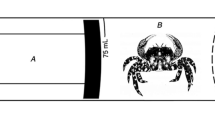Summary
Some aspects of the water relations of the terrestrial isopodsPorcellio laevis andPorcellionides pruinosus were investigated using a technique which provides a continuous record of the water lost by the specimen to a moving air stream. Water loss in both species varied considerably with time and was characterized by numerous moisture peaks due in part to movement by the animals. In living isopods, the water loss rate ofP. laevis was significantly higher than that ofP. pruinosus; however, the water loss rates of dead isopods were considerably lower than those of living animals, and the interspecific differences were absent after death. It was concluded that some additional avenue of water loss was present in living animals, although blockage of the mouth and anus ofP. laevis had little effect on the water loss rate. Cuticular permeability, measured in dead isopods, increased in both species with increasing temperatures (25 to 50° C), with the most marked changes occurring between 40 and 50° C. The increase in water loss rate persisted even after correction for saturation deficit.
Similar content being viewed by others
References
Becker FD (1936) Some observations on respiration in the terrestrial isopod,Porcellio scaber Latreille. Trans Am Microsc Soc 55:442–445
Bursell E (1955) The transpiration of terrestrial isopods. J Exp Biol 32:238–255
Cloudsley-Thompson JL (1956) Studies in diurnal rhythms. VI. Bioclimatic observations in Tunisia and their significance in relation to the physiology of the fauna, especially woodlice, centipedes, scorpions and beetles. Ann Mag Nat Hist 12:305–329
Cloudsley-Thompson JL (1969) Acclimation, water, and temperature relations of the woodliceMetoponorthus pruinosus andPeriscyphis jannonei in the Sudan. J Zool 158:267–276
Cloudsley-Thompson JL (1977) The water and temperature relations of woodlice. Meadowfield Press, Durham
Edney EB (1951) The evaporation of water from woodlice and the millipedeGlomeris. J Exp Biol 28:91–115
Edney EB (1954) Woodlice and the land habitat. Biol Rev 29:185–219
Edney EB (1958) The microclimate in which woodlice live. Proc Xth Int Congr Entomol 2:709–712
Edney EB (1968) Transition from water to land in isopod crustaceans. Am Zool 8:309–326
Edney EB (1977) Water balance in land arthropods. Springer, Berlin Heidelberg New York
Edney EB, Spencer JO (1955) Cutaneous respiration in woodlice. J Exp Biol 32:256–269
Gorvett H (1950) “Weber's Glands” and respiration in woodlice. Nature 166:115–116
Gorvett H (1956) Tegumental glands and terrestrial life in woodlice. Proc Zool Soc (Lond) 126:291–314
Hadley NF, Stuart JL, Quinlan M (1982) An air-flow system for measuring total transpiration and cuticular permeability in arthropods: Studies on the centipedeScolopendra polymorpha. Physiol Zool 55:313–404
Hoese B (1981) Morphologie und Funktion des Wasserleitungs-systems der terrestrischen Isopoden (Crustacea, Isopoda, Oniscoidea). Zoomorphology 98:135–167
Holdich DM, Lincoln RJ (1974) An investigation of the surface of the cuticle and associated sensory structures of the terrestrial isopod,Porcellio scaber. J Zool 172:469–482
Lindqvist OV (1971) Evaporation in terrestrial isopods is determined by oral and anal discharge. Experientia 27: 1496–1498
Lindqvist OV (1972) Components of water loss in terrestrial isopods. Physiol Zool 45:316–324
Mead-Briggs AR (1956) The effect of temperature upon the permeability to water of arthropod cuticles. J Exp Biol 33:737–749
Quinlan MC, Hadley NF (1982) A new system for concurrent measurement of respiration and water loss in arthropods. J Exp Zool 222:255–263
Verhoeff KW (1917) Zur Kenntnis der Atmung und der Atmungsorgane der Isopoda Oniscoidea. Biol Zentralbl 37:113–127
Verhoeff KW (1920) Über die Atmung der Landasseln, zugleich ein Beitrag zur Kenntnis der Entstehung der Landtiere. Z Wiss Zool 118:365–447
Warburg MR (1965a) The microclimate in the habitats of two isopod species in southern Arizona. Am Mid Nat 73:363–375
Warburg MR (1965b) The evaporative water loss of three isopods from semi-arid habitats in South Australia. Crustaceana 9:302–308
Warburg MR (1965c) Water relation and internal body temperature of isopods from mesic and xeric habitats. Physiol Zool 38:99–109
Wieser W, Schweizer G (1970) A re-examination of the excretion of nitrogen by terrestrial isopods. J Exp Biol 52:267–274
Zar JH (1974) Biostatistical analysis. Prentice-Hall, Englewood Cliffs
Author information
Authors and Affiliations
Rights and permissions
About this article
Cite this article
Quinlan, M.C., Hadley, N.F. Water relations of the terrestrial isopodsPorcellio laevis andPorcellionides pruinosus (Crustacea, Oniscoidea). J Comp Physiol B 151, 155–161 (1983). https://doi.org/10.1007/BF00689913
Accepted:
Issue Date:
DOI: https://doi.org/10.1007/BF00689913




